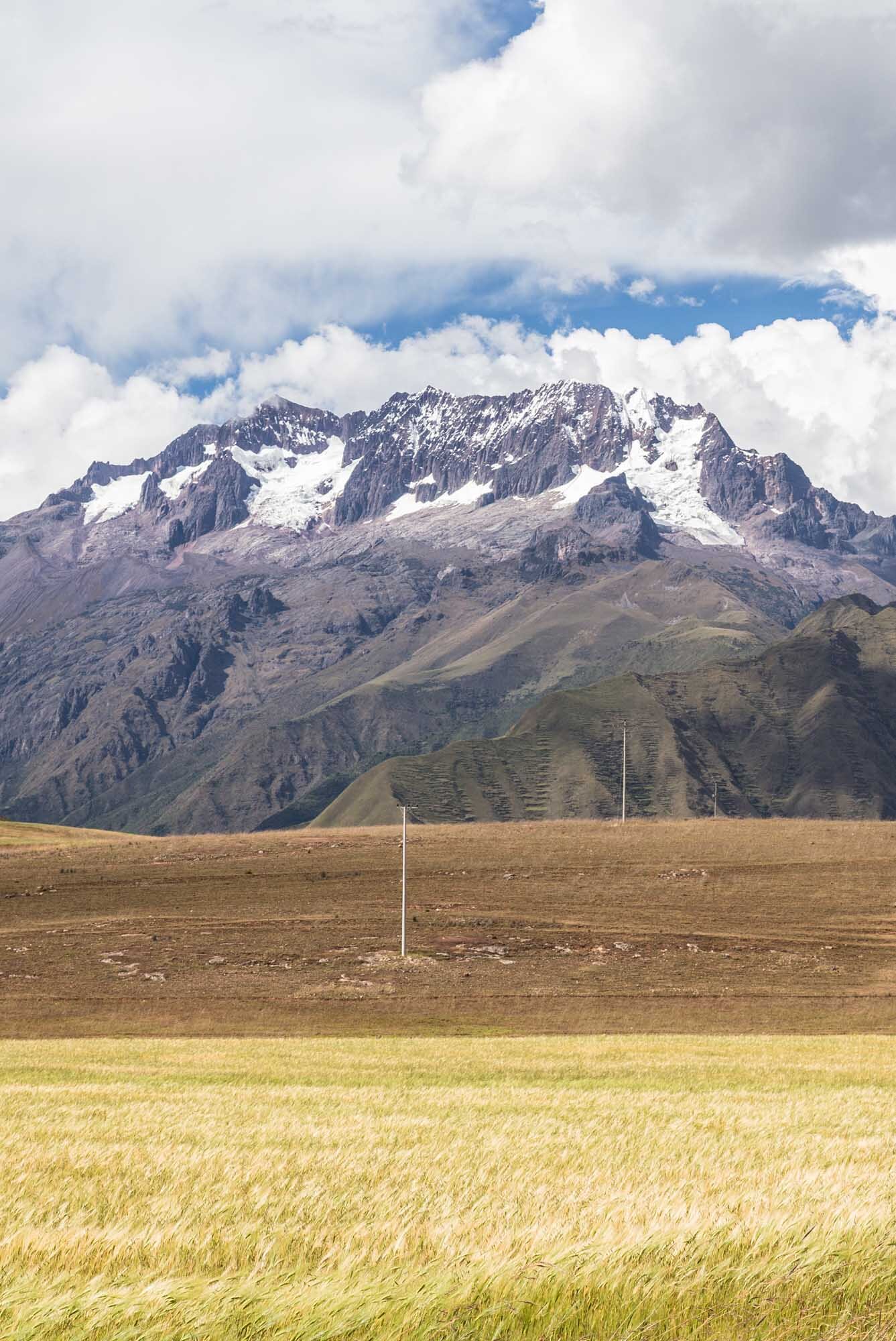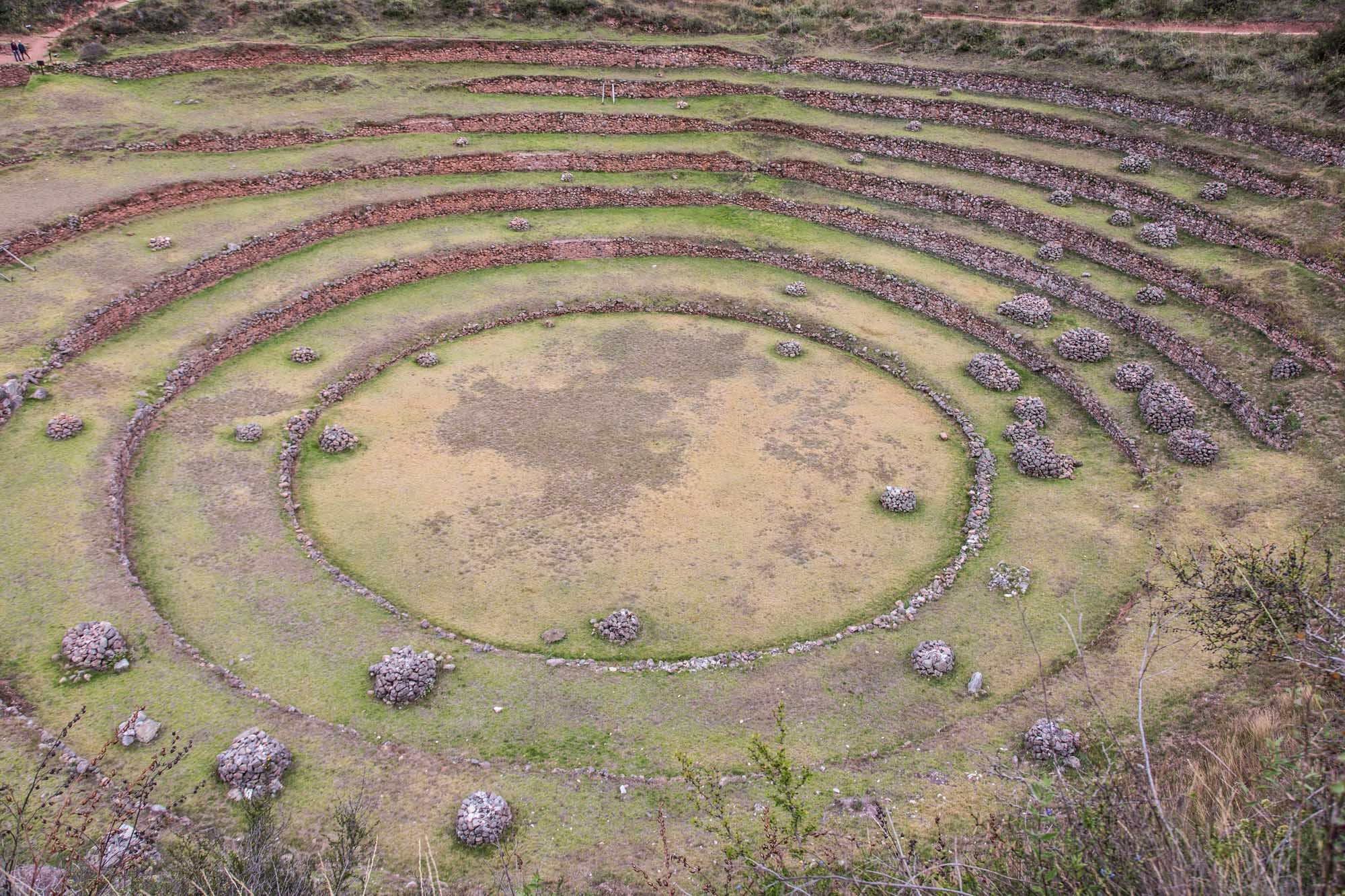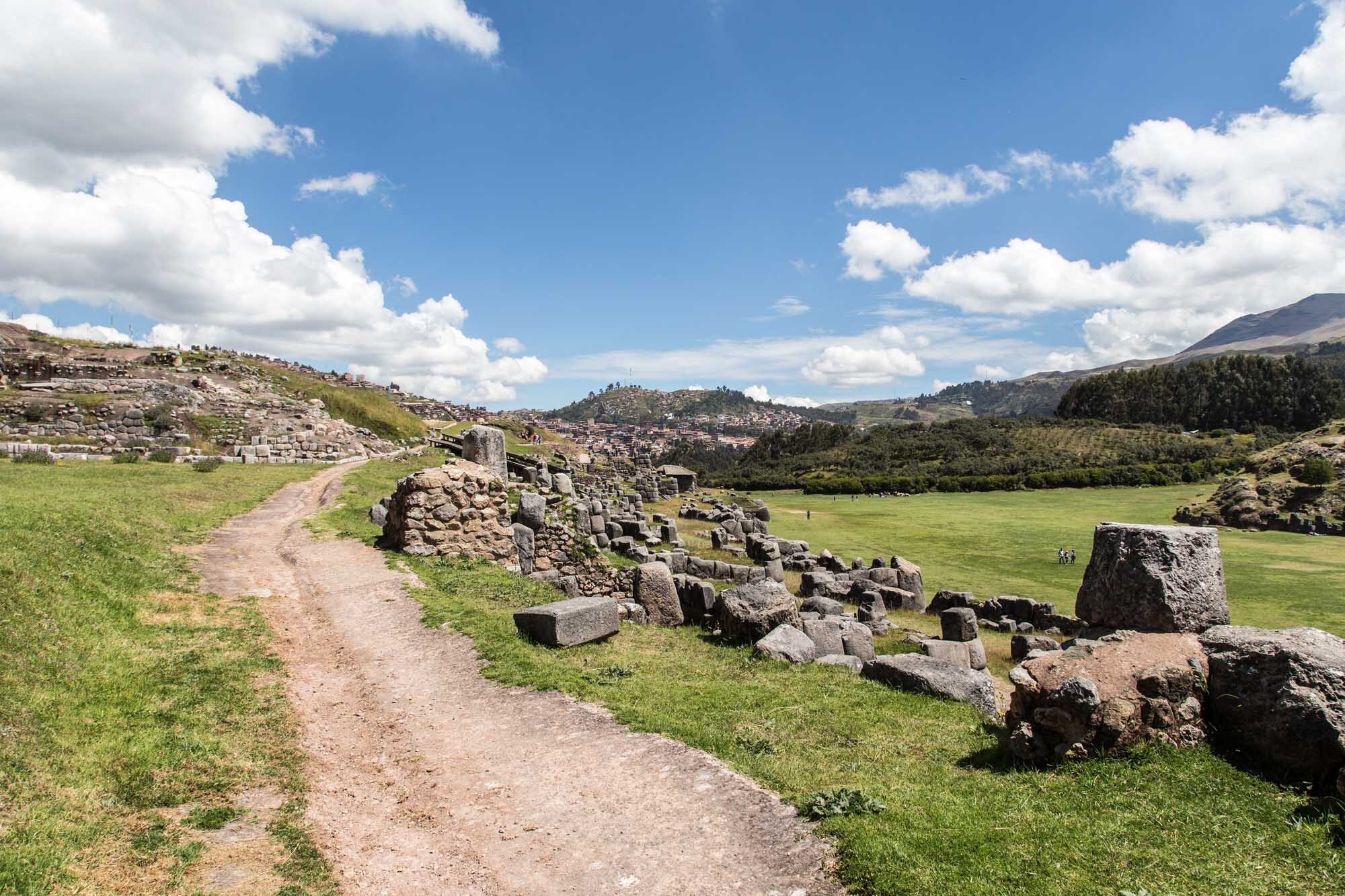
THE SACRED VALLEY
A day in the Sacred Valley of the Incas.
Cruising around the most marvellous Andean countryside, through salt mines, Inca ruins and Quechua markets.
A day-trip in the Sacred Valley is a thing to remember for life.
The valley has a distinct Peruvian feel and it’s like a treasure-chest full of natural beauties and uncountable areas of interest: a rural landscape dotted with Inca ruins, pretty villages and lush wheat fields, embraced by snow-capped peaks.
The power of Peruvian nature meets here the spontaneity of the local people.
Leaving Cusco early in the morning, we spent the full day roaming the Sacred Valley in Esteban’s car, a local guide and a private driver all in one person.
Our battle plan covered the impressive Saqsaywaman, the market in Pisac and the Salt Mines near Maras, ending at the ruins of Moray.
Cherry on the top, Esteban drove us for an unplanned detour through the Peruvian countryside, between local farmers and muddy roads cutting through the green hills.
Travellers can spend much more than a day enjoying the peaceful country-side feeling of the Sacred Valley: a stay in the valley hotels (like the Tierra Viva chain) will offer you the perfect base to explore the area for your adventures, experiencing the authenticity of the local culture.
RECAP & ITINERARY
When? April. How long? 1 full day. Temperature? Sunny and dry. Budget? 80-90€ per person (as a couple). It’s 80€ for a driver for the full day + 30€ pp for the Cusco Touristic Ticket + 3€ fee pp for Salineras de Maras + 10€ pp for lunch at Pisac Market. Planning needed? Moderate. What to book in advance? A driver for the day (we recommend Esteban). Google Maps itinerary? Here.
***
Morning // Saqsaywaman & Sacred Valley panoramic point
Lunch // Pisac market
Afternoon // Salineras de Maras & Moray archaeological site
Late afternoon // Detour in Andean countryside
THE URUBAMBA VALLEY
The Sacred Valley of the Incas (or Valle Sagrado) lies 15 km north of Cusco, unfolding its beauties from west to east, between the town of Pisac and Machu Picchu.
The powerful river Urubamba flows through the valley, shaping it since ancient times. The river is also known by the locals with its other name: Wilcamayu, the “Sacred River”.
The waters of the Urubamba river made the fortune of this valley by facilitating the trades to Cusco, while making the fields incredibly fertile for maize production.
The valley is around 100 km long and it’s protected by dramatic peaks on both sides, nearly reaching 6,000 metres of elevation (the Sahuasiray and Veronica stand above all).
The andenes – the celebrated pre-Colombian agricultural terraces – shape the slopes of the valley, while the floor is intensively cultivated with vegetables, corn, potatoes, avocado, coca and fruits.
THE TICKET
The Cusco Tourist Ticket or boleto turístico general is a key purchase to visit the attraction in Cusco and in the Sacred Valley.
The full version of the ticket costs S/.130 (30€) and is valid for 10 days from the day of the purchase, giving access to 16 attractions, including:
Museo de Sitio de Qorikancha in Cusco
Museo Histórico Regional
Museo de Arte contemporáneo
Saqsaywaman
Moray
Pisac ruins
Tambomachay
Both Machu Picchu and the Salineras de Maras are NOT included and tickets need to be purchased separately.
There are also 3 cheaper types of tourist tickets but they only grant access to a small number of sites (just museums or just ruins).
You cannot purchase a single ticket for a single attraction, so we suggest planning in advance what you want to see, and pick the ticket that works best for you.
You can buy the Cusco Tourist Ticket at the ticket office of any of these sites. We bought the full version at the Saqsaywaman box office, our first stop of the day trip.
HOW TO GET TO THE SACRED VALLEY
There are different ways to explore the Sacred Valley.
We had just one day to spare, so we asked our hotel, Casa Cartagena (read our review here), for a recommendation for a trusted driver.
Hiring a personal driver for the day is the best option to explore the Sacred Valley if you only have 24 hours to spend there. The driver will agree to an itinerary with you and he/she’ll drive you around, waiting for you in the car while you explore the city markets or the ruins.
Esteban cost us around 80€ cash for the day.
Tourists can also reach the valley with one of the many buses departing from Cusco: that’s perfect for budget travellers, especially for whoever wants to spend at least a couple of days in the valley, staying in one of the beautiful hotels.
Furthermore, there are many organised tours from Cusco: these are cheaper than a personal driver but won’t allow you the same flexibility, especially if you want to stop along the way to visit something specific you like.
Renting a car is a great option too, giving you total freedom on the itinerary.
OUR DAY TRIP
Hands down, the best day of our Peruvian trip.
We planned it lightly, leaving space to suggestions from the hotel staff and our driver. We decided to keep the budget to around 60-70€ per person all included.
Big breakfast, peppermint mouthwash and a very light day-bag: we were ready at 8am.
Just the time to shake our hands with Esteban – the hotel trusted driver – and we were already wriggling out of the narrow alleys of the city centre, heading towards our first stop of the day, just on the outskirts of Cusco.
In 10 minutes we approached an ancient fortress on the hills overlooking the city: Saqsaywaman.
SAQSAYWAMAN
Saqsaywaman is a 15th century citadel on the northern outskirt of Cusco.
This incredible complex was built by the Inca under the ruler Pachacuti and it’s the perfect place to appreciate Inca stoneworks, with their typical massive doors and giant stones, carefully cut and fit without mortar.
In the original city plan – when Cusco looked like a puma – the Saqsaywaman fort was the head of the animal.
The word Saqsaywaman (also spelled Sacsayhuaman) means in Quechua “place where the hawk is satiated”, as you can see many of these birds in its proximity.
The site is open from 7am to 6pm. You can spend a few hours roaming around the ruins, but if you want to just get an idea of the place, one hour is enough.
From the fortress, you will have the best aerial view of Cusco: check it below!
PISAC & THE MARKET
We wanted to be in Pisac for lunch-time to enjoy the endless food possibilities offered by the market, so we covered the 45 minutes to the village with just one stop.
The road to Pisac is very nice (and in good conditions overall) with soft turns and a sequence of stunning panoramas on the valley below.
It would deserve a stop every few hundred metres but – you know – tunnel vision from hunger can’t be controlled that easily, so we only stop a couple of times for some memorable pictures.
Pisac is a nice little village 30 km north of Cusco.
The village is most known for the colourful market (happening every Sunday, Tuesday, and Thursday) and some interesting Incan ruins nearby… we didn’t go but they are worth a visit if you have time!
There is a lively atmosphere in the cobbled streets of Pisac, it’s really worth a stop.
The Sunday market is especially famous because native sellers from different Quechua communities arrive in the village to sell their products, attracting flocks of tourists from Cusco.
The stalls are filled with colourful weavings, musical instruments, ponchos, jewellery, and alpaca clothing. None of these crafts are unique to the market but here you can find the perfect souvenir at an unbeatable price, compared to the big cities.
We totally recommend to be around the market at lunch time as there’s an incredible amount of food stalls offering a deep dive of rustic Peruvian cuisine.
A cheerful Peruvian lady invited us to eat in the tiny tables near her stalls, where we filled ourselves with rice, lentils, chicken and delicious roasted sweet potatoes. All of these for a few soles.
You can take pictures with the sellers but it’s important to always ask for permission and offer one or two soles to pay for their time.
THE FIELDS
After lunch we met back with Esteban, offering him a refreshing cola and the first thing he did was to pour a drop of it on the ground, like all good Peruvians.
“For the Pachamama” he said, winking at us. For Mother Earth.
Esteban picked the best route for the afternoon to reach our next destinations: the Salineras near Maras, just over an hour away from Pisac.
We got blessed by a fantastic sky, so during the whole ride we looked ecstatically at the panorama outside our window. Our expectations were high but the views of the imposing peaks around us exceeded them.
We stopped a couple of times to walk in a bright-yellow corn field, enjoying the fresh air and the peaceful atmosphere.
Probably the best panorama of Peru we had in our 3 weeks there.
THE SALINERAS DE MARAS
We arrived early afternoon at the fantastic Salineras de Maras, 40 km north-west of Cusco.
The picturesque salineras are made up by more than 3000 salt pools fed by an ancient underground spring, very rich in minerals.
They have been in use since Pre-Inca times and the people of the nearby village of Maras are keeping this tradition alive.
The view from the top of the valley is simply breathtaking.
The shallow pools are dug into the side of the Qaqawiñay mountain at 3,300 m and filled with salt water from the underground spring. When the water evaporates, it leaves behind crystallised salt, meticulously scraped by the local community, who still retain the mining rights of the site.
Each one of the evaporation pools is owned by a family from Maras. The locals extract the salt and sell many different salt-related souvenirs to the tourists (pink salt, coarse salt, salted chocolate, bath salt). We stocked up on cooking salt and salted chocolate, both for ourselves and for our friends at home!
The entrance fee for the Salineras is just S./ 10 (around 3€) and the site is open from 8am to 5pm.
The best time to go is during the dry season, from late October to May. You can’t enter the pools to avoid contaminations, but you can walk the tiny paths around them.
You can easily spend around one hour on the site, as it’s a perfect place to take gorgeous photos.
The salt mines can be reached with your on car, with a bus and also with a guided tour from Cusco.
MORAY
We brushed our clothes off the salt and jumped back in the car for the last destination of the day: the archaeological site of Moray, around 30 minutes driving from the salt mines, 50 km north-west of Cusco.
Moray is a bizarre archaeological site.
Half-way between a sci-fi stargate and a terraced farming site, this is the most unusual Inca ruins we saw in Peru.
This landmark is made of terraced circular depressions dug into the slope of a hill, where probably the Inca tried to create different climates to grow a variety of agricultural products.
The locals call these depressions andenes, and the largest one is 30 m deep!
Today we have greenhouses. Five hundred years ago, the Inca had Moray.
The Inca engineers made Moray their own micro-climate project, bringing here soil from different regions of the Empire. Thanks to the terraces depth and orientation with respect to the sun, each step downwards created a different temperature.
The bottom of the pit can be up to 15° C warmer than the top!
We hiked down the hill and walked around the pit to have a better look, and it really felt like being in a sci-fi movie.
The entrance fee of Moray is covered by the Cusco Tourist Ticket, and we suggest to spend at least around 30 minutes there.
THE COUNTRYSIDE DETOUR
Our full day exploring the Sacred Valley was demanding, but we asked Esteban for a small deviation from the original plan, so he could show us a more rural version of Peru, choosing a dirt road flanking the farms and fields of the area.
The tarmac was just a faded memory as the car speeded on the dirt road leaving clouds of dust behind.
Peruvian countryside is a magical place, especially the lush foothills around the Sacred Valley.
The panorama is dotted with adobe brick houses.
We spotted donkeys and farmers busy with their work who looked quite surprised by our passing, maybe tourists do not take that off the beaten path route so often?
We totally recommend asking for a countryside detour to your driver, or just do it by yourself if you rented a car.
Cusco welcomed us right before dinner time, Esteban delivered us back to our hotel safe and sound.
In just 12 hours we made so many memories: the friendly locals with their colourful dresses at the market, the rural villages, the impressive ruins and the muddy roads cutting through the green hills.
Simply unbeatable.































During a summer stroll through our beloved Camden Town we bumped into a colourful shop called "To Home from London" and we fell in love with the original hand-painted souvenirs in the form of mugs, magnetic coasters, eco friendly shopping bags and more.